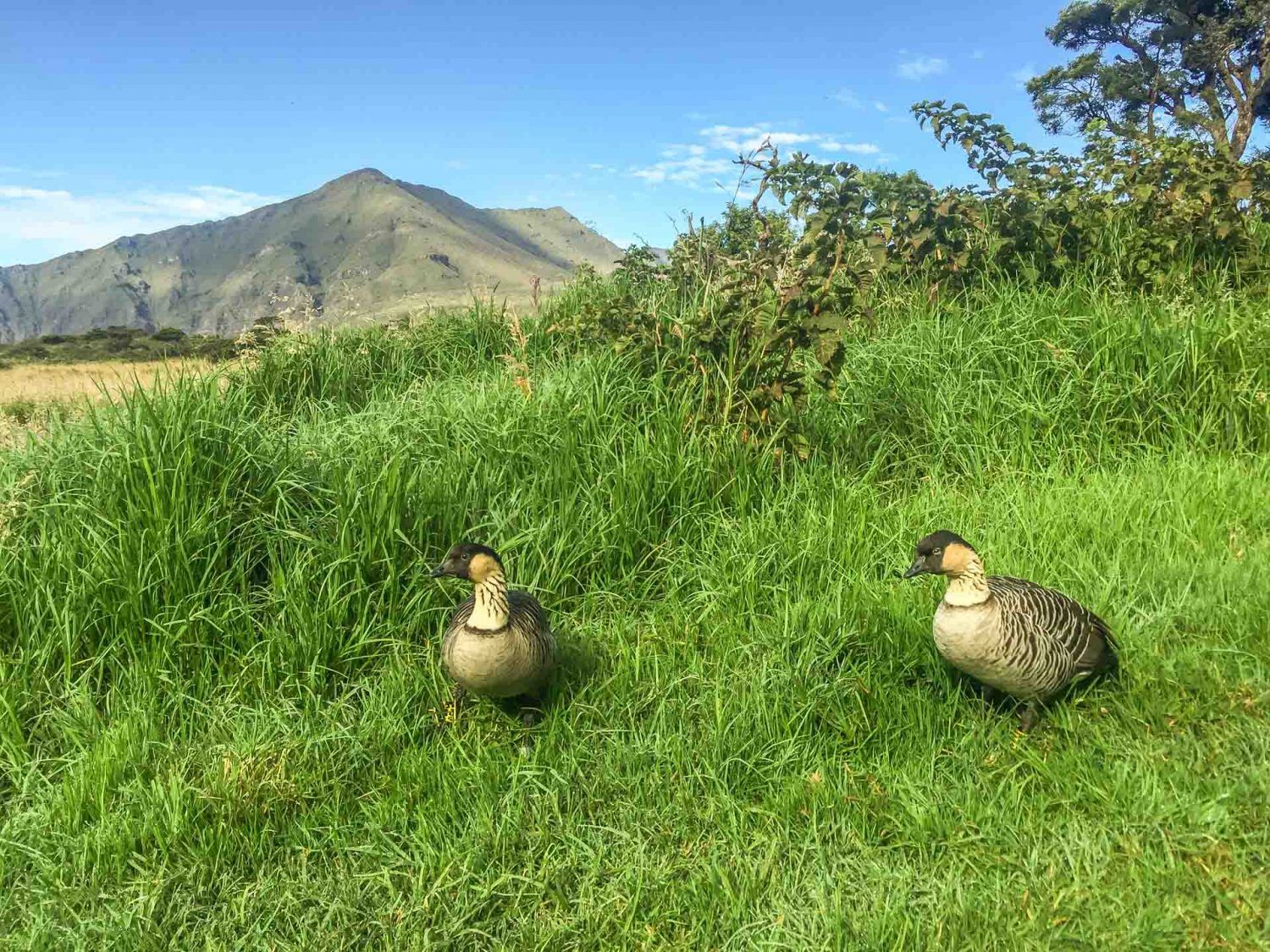
Native Plants & Animals Haleakala
NATIVE HAWAIIAN PLANTS & ANIMALS IN HALEAKALA NATIONAL PARK
The barren, moon like surface of Haleakala Crater may look like a lifeless place… and for the most part it is. However there are some very unique plants and animals here that are found nowhere else on earth and are perfectly suited to this extreme environment.
Unfortunately many of Haleakala’s plants and animal habitats are near extinction due to decades of invasive species and livestock destroying this fragile landscape. Years spent fencing off and reducing populations of these invaders has led to many areas of recovery… but the work is ongoing to this day. Below are some the plants and animals found here along with some ways you can help protect and preserve this beautiful but fragile habitat…

Native Plants of Haleakala
Here are a few of the plants that the Haleakala National Park Service and many island organizations and volunteers have worked tirelessly to save and/or reintroduce throughout this stunning National Park…
Argyroxiphium virescens
This is a plant that once thrived just above the dense rainforest at 6,000 – 7,000 ft elevation. The species was lost from the park lands due to cattle and goat grazing. Also much of the native forest that these plants evolved in is gone – having been logged during the sandalwood trade in the early 1800’s.
By the turn of the century the slopes were replanted (to reduce erosion) with eucalyptus trees which further damaged the soil with their oily leaves and bark. Eucalyptus, in there dry native Australian habitat, evolved to pull as much moisture as possible from the soil. In Maui these trees and their roots pulled all available water out of the soil, leaving a dry oily soil that is difficult for native plants and trees to survive in. Eucalyptus eradication and native reforestation efforts are ongoing today and Haleakala National Park has plans to reintroduce this silver sword relative and other native plants back into the park from found and very remote surviving population.
Native Animals on the Slopes of Haleakala Volcano
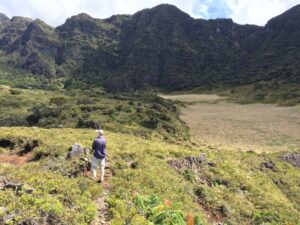
Species that are native to Hawaii arrived here in one of three ways: in the wind, by the wings, or in the waves. During ancient times (before the arrival of humans) a new species arrived in Hawaii every 10,000 to 100,000 years. Today new alien species arrive (due to shipping and tourism) in Hawaii at a rate of 20 per year. Please kokua (help) by cleaning out luggage, golf bags and shoes of debris that may hide invasive species before flying to our beautiful island…Mahalo!
The Nene Goose
The Nene Goose – Hawaii’s State Bird
One of the most well known animals you may encounter along the way up to the crater is the Nene (Hawaiian goose). A relative of the Canada goose, the nene is Hawaii’s state bird. Standing about 2 feet high with a black head, yellow cheeks and beautifully striped neck these birds were hunted almost to extinction. The Nene is the world’s rarest goose, though the estimated population at the time of Captain Cook’s arrival in 1778 was 25,000, by 1952 introduced predators such as cats and the asian mongoose reduced the population to 30 birds.
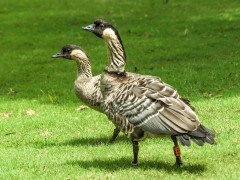
Today the wild Nene population on Maui number approximately 450 (250-300 within Haleakala National Park), and the species remains endangered. They are a bit smaller than the Canadian goose with very little webbing between their toes (an evolutionary adaptation for living on lava fields on the mountain slopes far from standing water).
Most of todays populations of Nene live on the western slopes of Haleakala between 5500-8000 feet with some in the West Maui Mountains between 3000- 4000 feet. Breeding pairs have also been seen in the fields around Makawao and also Kahili Golf Course in central Maui which stretches along the lowlands of the West Maui Mountains. (near Waikapu).
Want to help protect these endangered species? You can Adopt-A-Nēnē through the Friends of Haleakala National Park, an orginization of volunteers doing service work within this National Park. All proceeds go directly to protecting and managing endangered species. For more information go to www.fhnp.org
The Pueo
The Pueo – Sacred Owl
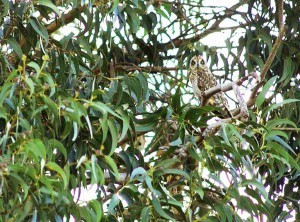
The Pueo is one of the more famous of the various physical forms assumed by ʻaumakua (ancestor spirits) in Hawaiian culture. According to Hawaiian mythology owls are said to rescue lost souls from the underworld and guide armies to safety. Hawaiian legends say the god Kane took the form of an owl in battle to protect his people.
The Pueo inhabits forests and grasslands throughout the islands of Hawaiʻi. Unlike many owls Pueo hunt during the day and are most active at dawn and dusk. The introduced Barn Owl competes with the Pueo for food. Many Pueo sightings are actually barn owls who are larger with a white heart shaped face and dark eyes as opposed to the Pueo’s yellow eyes and spotted face.
Pueo nest on the ground making them more vulnerable to introduced mammals like rats, mongoose, and cats. They can be seen along the slopes of Haleakala gliding and hovering over the pastures and forests hunting for rodents. It is considered a “good luck” omen when a Pueo flies overhead.
Today they encounter many threats and it is believed their numbers are declining. They can become disoriented from light pollution and have been found dazed along roadsides and have even been known to crash into car headlights. If you find an injured or dazed Pueo owl please notify DLNR Division of Forestry and Wildlife at 808-984-8100
The ’Ua’u
The ‘Ua’u – Hawaiian Petrel
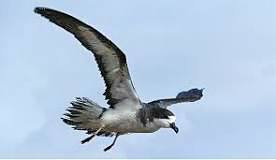
Before the first canoes arrived from the southern islands of polynesia birds ruled the islands. Scientists estimate that seabird populations were equivalent to the reports of the first western explorers who proclaimed that seabirds were so abundant that they blackened the sky. Fossil records indicate ancient Hawaiians favored them as a food sources. In fact it is known that the Ali’i (ruling class) enjoyed the Hawaiian Petrel chicks as a delicacy reserved only for royalty.
Archeologist Storrs L Olson’s study of seabird bones indicates there were 39 species of seabirds in the main Hawaiian Islands before Polynesians arrived. By the time of western contact more than half of them were extinct due to predation and loss of habitat from humans.
The Hawaiian Petrel, along with the Shearwater Petrel, were the most plentiful of the seabirds and survive today due, in part, to their migratory nature. These fairly large birds have a 3 foot wingspan and nest in the lava cliffs of Haleakala crater during their breeding season running from March through October. They feed out to sea during the day and return to feed their chicks only at night. It is believed they navigate by the stars and can become confused by urban street lights, flying around them until exhausted and fall to the ground. If you find one please call the National Park Service at 1-877-428-6911 for further instructions
The ‘Ope‘ape‘a – Hawaiian Bat
The Hawaiian Bat – Hawaii’s only endemic land mammal
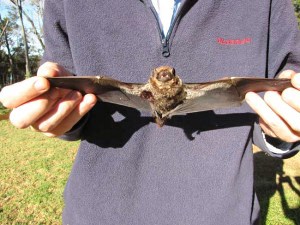
This tiny bat is the only endemic native Hawaiian land mammal in existence. It is estimated to have arrived in Hawai’i around 10,000 years ago. It’s body is similar in size and weight to a mouse with a 10 to 13 inch wingspan. The Hawaiian word ‘ope’ape’a means “half leaf” and refers to their wings resembling one half of the taro leaf.
It was originally considered a subspecies of the Hoary Bat, which is common throughout the continental U.S. until 2015 when new molecular research showed that they are a distinct species all their own. It has a heavy fur coat of brown or gray and hunts insect through the night from sea level to the summits of Maui, Kauai and the Big Island of Hawai’i. Relatively little is known about these solitary bats that roost in the high treetops and their total numbers are not known.
From May to June they give birth to twins and carry their tiny pups on night forages as they snatch both native and non-native insects they find in forests and over the ocean. They have been known to reach flight speeds of up to 60 miles per hour!
Researchers know the ‘ope’ape’a are in Haleakala National Park both at the summit and in the crater. The threats to these animals are not clear but one known cause of death is collision with man-made objects such as communication towers and barbed wire fences. This is possibly due to the their echo-location being turned off for a few seconds after catching a flying insect to feed. If you find an injured or dead bat please contact Fern Duvall, Wildlife Biologist with the Department of Land and Natural Resources, at 808-873-3502.
Introduced Species To The Island Of Maui & Hawaii

Plants, birds and insects arrived in Hawaii over many thousands of years and evolved into what is called endemic species – plants and animals found nowhere else in the world. Scientists estimate that before humans arrived some 1500 years ago the islands had fully developed forests full of birds and a bountiful ocean. Archeologist and botanists believe the arrival of Polynesians in the 1st century proved almost as destructive to Hawaii’s native ecosystem as the arrival of westerners in the 18th century.
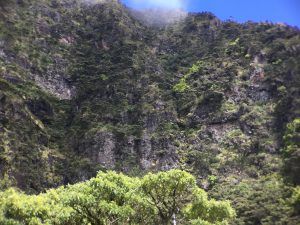
Battling native plant and animal extinction is a constant challenge in Haleakala National Park though many endemic species are making a comeback due to the park’s nearly 30 years of fence building and feral animal eradication. However some non native species pose little threat and have adapted to this harsh environment much like their native counterparts.
Introduced game birds include the Chukar Partridge and Ringneck Pheasant on Maui, the California quail on Molokai and Hawaii, the Gambel’s quail and wild turkeys on Lanai and Molokai and mourning doves on all islands have flourished. Other introduced exotic species include the Gray Francolin from Asia, Black Francolin and Erkel’s Francolin from Africa, Green Pheasants from Japan, Kalij pheasants from Tibet, a Japanese Quail, an African Sandgrouse and several species of Asian Doves round out the introduced game birds seen throughout the islands. Below are brief descriptions of some of the introduced birds and animals that you may encounter along the slopes of Haleakala….
The Chuckar
The Chukar Partridge
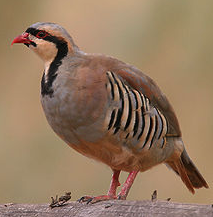
A non-native species that you may encounter at Haleakala’s summit area is the Chukar partridge. This game bird was introduced to the islands in 1942 as an army food source during World War II. After the war the birds were released on the upper slopes of Haleakala in 1954 along with pheasants and grouse. They can often be seen at the summit Visitor Center enjoying the sunrise with visitors.
Native to Pakistan, Afghanistan and Nepal the Chukar Partridge was introduced to Hawai’i, as it was in North America, as a game bird. The species is in the pheasant family of upland birds and has black and white bars on it’s sides and a black band running from it’s forehead, across the eyes and down the neck. They have a red beak and legs putting them in a category with several other “red legged partridges”.
Though the Nene Goose is rarely seen above 8000 ft elevation Chukars, originally from the Himalayas, are accustomed to high elevations and can be seen throughout Haleakala and the volcanoes of the Big Island to elevations as high as 13,000 ft.
Chukars Partridges in Haleakala National Park may play a beneficial role, similar to the Nene Goose, by dispersing native plant seeds.
The Mongoose
Mongoose in Hawai’i

This invasive species has been one of the most destructive arrivals to the islands. Their native habitat in southern Asia stretches from Iraq to China. By the mid 1800’s sugar production was taking off and many tropical islands began to fill with sugar cane plantations. With sugar cane fields came rats who were attracted to the sweet plants, causing crop destruction and loss of profit. Hawaii plantation owners heard of a way to control the rat population by introducing the mongoose.
In 1883 several Hawai’i plantation owners shipped 72 mongoose from Jamaica to the Big Island. These animals were raised and their offspring were shipped to plantations on other islands. However they did not have the desired effect as the mongoose hunts mostly during the day and rats are nocturnal. They did however hunt birds and bird eggs. This resulted in native Hawaiian forest bird reductions and extinctions. It is now illegal to have a mongoose as a pet or propagate them in any way. Efforts are ongoing to eradicate them from Maui and Haleakala National Park.
Though this is just a small sample of native and non-native animals in Haleakala they are some of the more common species that you may have a chance to see while visiting Maui. We highly encourage visitors to find out more by taking guided tours both inside Haleakala National Park and outside the park to areas like the road to Hana. It’s fun to learn while on vacation!
Aloha Nui Loa








